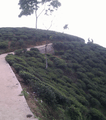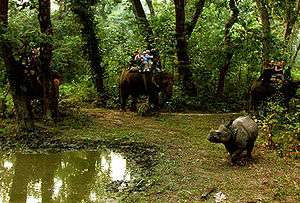Tourism in Nepal

Tourism is the largest industry in Nepal and its largest source of foreign exchange and revenue. Possessing eight of the ten highest mountains in the world, Nepal is a hotspot destination for mountaineers, rock climbers and people seeking adventure. The Hindu and Buddhist heritage of Nepal and its cool weather are also strong attractions. [1]
Overview

Mount Everest, the highest mountain peak in the world, is located in Nepal. Mountaineering and other types of adventure tourism and ecotourism are important attractions for visitors. The world heritage site Lumbini, birthplace of Gautama Buddha, is located in the south of the West region of Nepal (which despite the name is located in the centre of the country) and there are other important religious pilgrimage sites throughout the country. The tourist industry is seen as a way to alleviate poverty and achieve greater social equity in the country.

According to statistics of 2012, there was a slow growth rate of 9.8%. According to statistics from Nepal Tourism Board (NTB), a total of 598,204 foreign tourists entered the country via aerial route in 2012. The government of Nepal declared 2011 to be Nepal Tourism Year, and hoped to attract one million foreign tourists to the country during that year.[2] The government of Nepal has also declared Lumbini Tourism Year 2012 to promote Lumbini.
Tourism in Nepal was badly affected, at least temporarily, by the series of earthquakes in 2015.
Statistics
In 2007-, the number of international tourists visiting Nepal was 526,705, which was an increase of 37.2% compared to the previous year. In 2008, the number of tourists decreased by 5% to 500,277.
In 2008, 55.9% of the foreign visitors came from Asia (18.2% from India), while Western Europeans accounted for 27.5%, 7.6% were from North America, 3.2% from Australia and the Pacific Region, 2.6% from Eastern Europe, 1.5% from Central and South America, 0.3% from Africa and 1.4% from other countries.
Foreign tourists visiting Nepal in 2008 stayed in the country for an average of 11.78 days.[3][4]
Arrivals
| Year | Number of international tourists arriving in Nepal [5] | % change from previous year |
|---|---|---|
| 1995 | 363,395[6] | |
| 1996 | 393,533 | 8.3 |
| 1997 | 421,857 | 7.2 |
| 1998 | 463,684 | 9.9 |
| 1999 | 491,504 | 6.0 |
| 2000 | 463,646 | -5.7 |
| 2001 | 361,237 | -22.1 |
| 2002 | 275,468 | -23.7 |
| 2003 | 338,132 | 22.7 |
| 2004 | 385,297 | 13.9 |
| 2005 | 375,398 | - 2.6 |
| 2006 | 383,926 | 2.3 |
| 2007 | 526,705 | 37.3 |
| 2008 | 500,277 | -5.0 |
| 2009 | 509,956 | 1.89 |
| 2010 | 602,855 [7] | 18.2 |
| 2011 | 736,215 [8] | 21.4 |
| 2012 | 803,092[9] | 9.1 |
| 2013 | 798,000[10] | -0.7 |
Arrivals by country
Most tourists arriving to Nepal on short term basis in 2015 were from the following countries of nationality:[11]
| Rank | Country | Number |
|---|---|---|
| 1 | 66,984 | |
| 2 | 44,367 | |
| 3 | 42,687 | |
| 4 | 30,953 | |
| 5 | 29,730 | |
| 6 | 18,619 | |
| 7 | 18,112 | |
| 8 | 17,613 | |
| 9 | 16,405 | |
| 10 | 16,405 | |
| Total | 538,970 |
Wilderness tourism
| Chitwan National Park | |
|---|---|
|
IUCN category II (national park) | |
|
Elephant safari with rhinos |
According to Nepal's Ministry of Tourism, major tourist activities include wilderness and adventure activities such as mountain biking, bungee jumping, rock climbing and mountain climbing, trekking, hiking,[12] bird watching, flights, paragliding and hot air ballooning over the mountains of Himalaya, exploring the waterways by raft, kayak or canoe and jungle safaris especially in the Terai region.[13]
 Ilam, tea capital of Nepal and one of the tourism hotpots in eastern Nepal
Ilam, tea capital of Nepal and one of the tourism hotpots in eastern Nepal The only international elephant polo in Chitwan National Park
The only international elephant polo in Chitwan National Park
Religious sites
The major religion in Nepal is Hinduism, and the Pashupatinath Temple, the world's largest temple of Shiva, located in Kathmandu, attracts many pilgrims and tourists. Other Hindu pilgrimage sites include the temple complex in Swargadwari in the Pyuthan district; Janaki Mandir in Janakpurdham in Mithila region; Lake Gosainkunda near Dhunche; the temples at Devghat; Manakamana temple in the Gorkha District; Pathibhara near Phungling; and Mahamrityunjaya Shivasan Nepal in Palpa District where the biggest metallic idol of Lord Shiva is located.
Buddhism is the largest minority religion. The World Heritage site at Lumbini, which is traditionally considered to be the birthplace of Gautama Buddha, is an important pilgrimage site. Another prominent Buddhist site is Swayambhunath, the Monkey Temple, in Kathmandu.
Dang valley is a sacred place for Hindus as well as other religions. Kalika and Malika Devi in Chhillikot hill, Ambekeshawori temple, Krishna temple, Dharapani temple are among the sacred places in Dang district. Chillikot hill is also a good place for sightseeing and also an ancient palace of a king.
Muktinath is a sacred place for Hindus as well as Buddhists. The site is located in Muktinath Valley, Mustang district.
See also
References
- ↑ Turner, Rochelle. "Travel & Tourism Economic Impact 2015 Nepal". World Travel & Tourism Council. Retrieved August 2, 2016.
- ↑ Nepal aims to attract 1 million foreign tourists next year Xinhua News Agency, accessed 21 November 2010
- ↑ Survey report, Government of Nepal, Ministry of Finance, accessed 21 November 2010
- ↑ Nepal Tourism Statistics 2010 Report, Government of Nepal, Ministry of Tourism, and Civil Aviation, accessed April 3rd, 2012.
- ↑ Department of Tourism (Nepal) (June 2013). "Nepal Tourism Statistics 2012" (PDF) (Visitor Arrivals). Retrieved 2016-10-28.
- ↑ http://www.icptr.com/wp-content/uploads/2011/01/Tourism-Amidst-Armed-Conflict.pdf
- ↑ http://www.tourism.gov.np/uploaded/pdf/Nepal-Tourism-Statistics-2010-provisional-report.pdf
- ↑ "Nepal welcomes only 730,000 visitors during Nepal Tourism Year 2011 Nepal tourism misses 1 million ...". Retrieved 11 June 2015.
- ↑ http://www.tourism.gov.np/uploaded/TourrismStat2012.pdf
- ↑ "798,000 tourists visited Nepal in 2013,arrivals down by 0.7 %". Retrieved 11 June 2015.
- ↑ Nepal Tourism Statistics 2015
- ↑ "Popular Hiking Routes in Nepal". Everest Uncensored. Retrieved 11 June 2015.
- ↑ Major Tourism Activities, Nepal Ministry of Culture, Tourism and Civil Aviation, retrieved 21 October 2014
External links
-
 Nepal travel guide from Wikivoyage
Nepal travel guide from Wikivoyage - Official tourism website
- Ministry of Tourism and Civil Aviation

